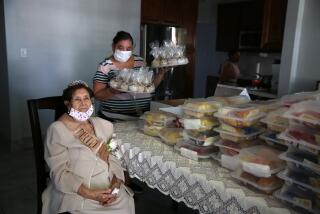Requiem for the Last Vaquero
- Share via
For most of his 97 years, Reyes Serrano rode wild horses, rounded up cattle, hunted bobcats, chewed tobacco, smoked cigars and downed a shot of whiskey with breakfast every morning.
Until he moved into a nursing home two months ago, he spurned Orange County’s “city life,” living in Trabuco Canyon out of view of the houses and strip malls that encroached upon the open hills where he once worked.
This morning, the cowboy revered by local historians as California’s oldest vaquero, whose great-grandfather received the original Mexican land grant of 10,000 acres that would later be called El Toro, will be returned to his ancestral land, to be buried beneath a towering oak tree.
Serrano, born on a Juaneno Indian reservation in San Juan Capistrano on Jan. 6, 1901, died Tuesday of pneumonia and cardiac arrest. His burial, at 10 a.m. at El Toro Memorial Park, will be a simple prayer service, punctuated by the singing of an Indian song.
“We’ve lost another of the dwindling remnants and memories of the area’s past,” said Joe Osterman, a local historian who grew up with Serrano’s two daughters. “The links with what used to be El Toro are gradually disappearing.”
Eddie Grijalva, who also grew up in the area, said Serrano was “a real cowboy, a man’s man, a real rugged old guy. He was a different breed that’s now gone. We don’t have that kind of people anymore. It’s sad.”
Serrano’s great-great-grandfather was Don Francisco Serrano, who served as chief executive officer of the pueblo of Los Angeles in 1799. Don Francisco’s son, Don Jose Serrano, received the El Toro land in 1846 as part of a sweeping series of land grants in Orange County.
After a drought in 1863-64, however, the property was taken by bankers. Rather than leave the area, the Serranos stayed to work the land. Reyes Serrano worked mostly as a cowboy, sometimes as a farmer, on the Irvine, Mission Viejo and Moulton ranches, back when cattle grazed where subdivisions now rest.
He had to give up raising cattle about 10 years ago when he broke his leg. A cow having a difficult birth had rolled over and knocked him into a ditch.
He and his wife, Dora, lived for many years in Laguna Canyon, then moved to the El Toro area. Their last home was a trailer in Trabuco Canyon.
The couple were fighting mad when local residents voted to change the historic name of El Toro to the more upscale Lake Forest in 1991.
“He was real content there until they changed the name,” said his daughter, Agnes Urmson of Costa Mesa.
Dora died three years ago after a stroke. Reyes continued to live in the trailer, cared for by his granddaughter, amid dogs, peacocks and other animals.
In May, he moved into the nursing home, reluctantly giving up his tobacco and whiskey and just staying in bed, his daughters said.
But he relished his habits until then, family friend Grijalva recalled.
“When I last visited him, there he was sitting underneath his old pepper tree,” Grijalva said. “He went in and came out with a half gallon of strong whiskey and said, ‘Come on, Grijalva, let’s have a drink.’ And my God, I could barely swallow the stuff. But he gulped it down and said, ‘Ah, this is good. . . .’ ”
More to Read
Sign up for Essential California
The most important California stories and recommendations in your inbox every morning.
You may occasionally receive promotional content from the Los Angeles Times.













